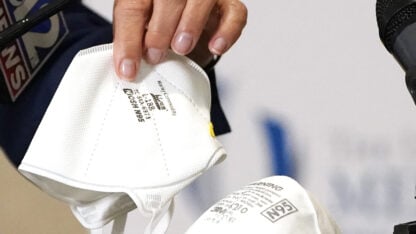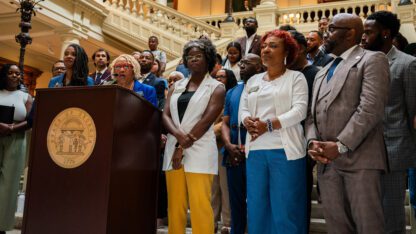Delta Air Lines Crew Reflects On Piloting Hurricane Relief Flights To Bahamas
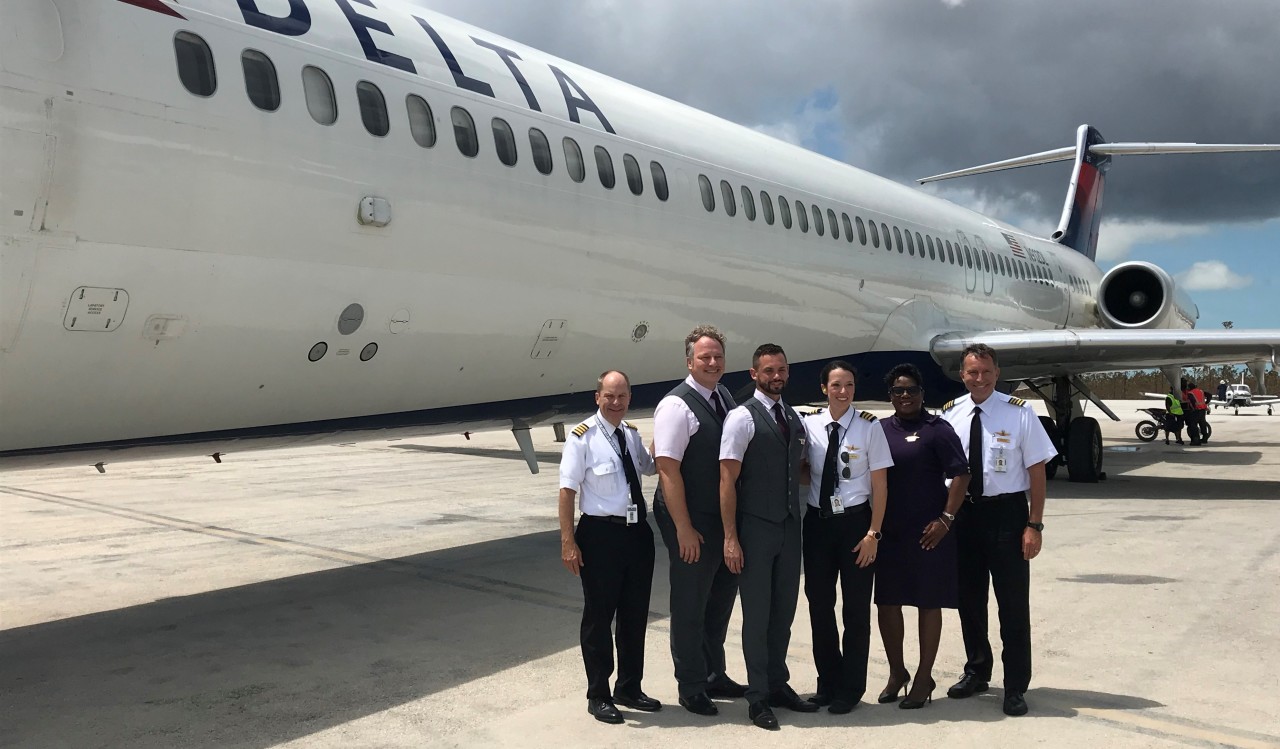
The crew of Delta flights 9994/9995 pose in front of the MD-88 aircraft they piloted to bring relief supplies in, and evacuees out, of the hurricane-ravaged Bahamas. Seen here are, left to right, Captain Carl Nordin; Flight Attendant Sergij Novak, General Manager-Inflight Field Operations; Flight Attendant Alexis Garcia, Field Service Manager, Ft Lauderdale/Miami; First Officer Erica Jefcoat, Flight Operations Duty Manager; Flight Attendant Christi Jackson Field Service Manager, Atlanta; Captain Michael Sweat, Lead Line Check Airman, MD88/90.
courtesy of Capt. Carl Nordin, Delta Air Lines
One recent Friday night Capt. Carl Nordin got a call.
Nordin, a Delta Air Line chief line check pilot for the MD-80/90-series aircraft, learned Delta executives had tapped a “Mad Dog” (as the aircraft are known), to handle relief flights to the hurricane-ravaged Bahamas.
The decision to use the MD-88 was one of prudence.
With what Hurricane Dorian left of the island nation days earlier, an easy rear entry/exit option that wasn’t dependent on a ground crew amounted to an insurance policy. The MD-88 has built-in stairs at the rear of the fuselage. Decision made.
“I knew it was going to be a difficult type of mission,” Nordin said, reflecting on that initial phone call. “It’s important that I be part of it.”
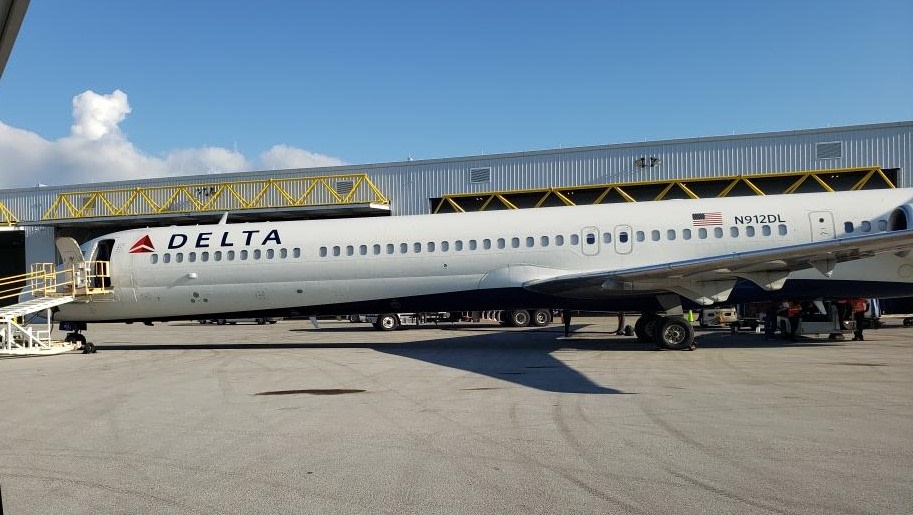
Delta gave Nordin the latitude to pick his own crew. And all morning Saturday he’d been communicating with First Officer Erica Jefcoat, who was pulling a shift on the desk as duty pilot. Jefcoat had been a conduit between Delta and the seasoned pilot. At the close of one of the briefings, Jefcoat said without much thought, “Let me know how I can help.”
It was a genuine offer, although she wasn’t exactly expecting him to take her up on it—at least not to the degree he did.
Nordin asked her to co-pilot the flight.
“It takes a lot of moving parts to get a Delta plane anywhere,” Jefcoat said. “It also takes a lot of moving parts to get me anywhere, because my whole village has to kind of step in and cover,” she added, noting her two young children and husband — a pilot himself — are involved in the coordination.
Jefcoat said her family had initial concerns over her safety, but that after talking it through, they were satisfied she’d be okay. Jefcoat agreed. She left Delta’s Hapeville headquarters early Saturday afternoon, dashed home to the north side to pack her bags, and was back at the airport, in the cockpit and ready to take off, in less than four hours.
For Delta field service manager Christi Jackson, the phone call came at about 1 p.m. Saturday. She was getting her hair done and used the rest of the time in the hairdresser’s chair to coordinate her plans.
Four hours later and she too was at the airport with suitcase in hand. Delta had called on Jackson a few times over the years to assist on relief flights, so she was familiar with the process. So instead of focusing on what she needed, Jackson said she turned her attention to anticipate her passengers’ needs.
“I was just concerned about [how] we’re going to meet their expectations and take care of the customers because they had been through a lot of trauma,” Jackson said. “But we want to lessen what they had gone through by providing them customer service, compassion, and love on our aircraft.”
After a supply stop in Fort Lauderdale, the crew was on their way to the Bahamas. Nordin said 20 Delta employees at all levels were on the 53-minute flight. It took that many, he said, to make the mission work. And as the 149-seat MD-88 banked left on final approach to Leonard M. Thompson International, Capt. Nordin noticed as much of what wasn’t there as what was.
“It’s a short, narrow runway,” Nordin said of Marsh Harbor, noting the narrowness of the runway meant additional restrictions.
With taxiways just 50-feet wide, Nordin said it was anything but a normal operating environment.
“And, of course, we didn’t know what the conditions were on the ground, either” he noted.
There were no painted markers or centerline on the runway, and no glide slope information to tell pilots if they’re too high or too low in the critical moments coming in for a landing.
“So it was all a little concerning,” Nordin said.
First Officer Jefcoat’s primary concern involved communicating. She said all over the Bahamas, lots of aircraft dotted the airspace. But with no control tower to safely separate the aircraft. it’s up to each plane to announce where it is and to keep away from other nearby aircraft. That undertaking was enough to keep Jefcoat’s plate full. Often, she said, she’d go to announce the aircraft’s position, only to hear another pilot beat her to the frequency by a millisecond.
For the 32-year-old MD-88 screaming toward the runway at 150 miles an hour, there’s a lot that could go wrong in such a scenario. And quickly.
“There wasn’t a lot to see flying in, immediately around the airport,” Jefcoat noted of the conditions at Marsh Harbor. There was a lot of debris on the airfield itself, although the runway was clear, she said.
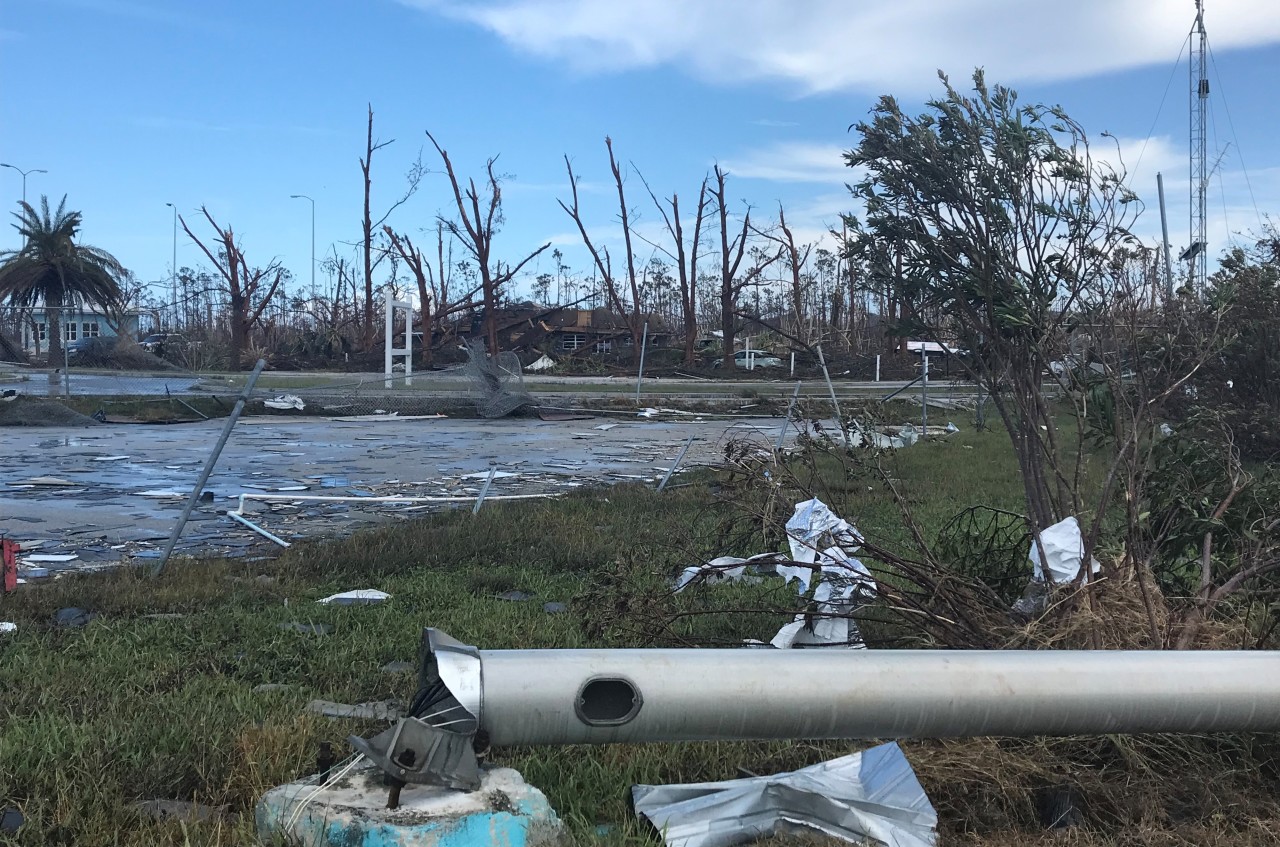
With no markers, no instruments, and asphalt half as long as runway they took off from, it was anything but a typical landing. But the crew got the flight down early on the runway without incident.
And that’s when Jefcoat’s thoughts shifted from the front of the plane to those who would soon occupy the back—folks evacuating their homes.
“Are we able to meet the needs of these people, other than just taking them out of here?” she said, worried that her crew’s efforts weren’t enough.
Amid the airport’s snapped trees and scattered debris stood lines of people, each eager to get off the island and to a more stable location. The Delta aircraft was packed with relief supplies, which crews quickly unloaded to free up space for at least some of those waiting in line.
Jefocat knew that process would take a few hours.
“There’s a lot of hurry up and wait,” she said, pausing to wipe tears from her eyes. It’s in those moments that “you step out of being a Delta pilot.” Jefcoat said when that happened, she took a moment to look around, touched by the spirit of the mothers and their children. As the tears flowed, Jeffcoat said the whole experience humbled her.
As those evacuating Marsh Harbor boarded Delta’s plane for Nassau–thankful to finally be getting out—Delta Field Service Manager Cristi Jackson’s face offered a warm, welcoming smile. It’s her nature. She handed toys and candy out to the children, whom, afterall, were her passengers.
After the 47-minute jaunt to Nassau and bidding farewell to the departing passengers, the MD-88 crew flew the aircraft to its Ft. Lauderdale base for the night.
None of them slept.
They couldn’t, they said, because the day’s events weighted so heavily on their minds.
That was Sunday. The next day, they repeated the events before returning home to Atlanta.
It took an “incredible amount of coordination to try and pull this off,” Capt. Nordin said. “Really, it’s just overwhelming to think about how complex it was. But the ability to do it–and the fact that we did do it–is really a heartwarming moment for me,” Nordin added.
And if the phone were to ring right now with the same request, would they do it again?
Without hesitation, and in unison, the trio offered a convincing “Yes.”


